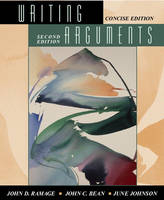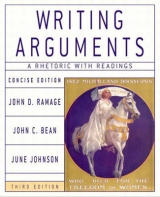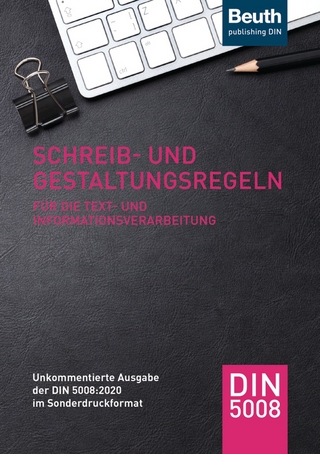
Writing Arguments
Pearson (Verlag)
978-0-205-31747-9 (ISBN)
- Titel erscheint in neuer Auflage
- Artikel merken
The market-leader in argumentative rhetorics, Writing Arguments has been praised for its clear explanation of the Toulmin approach, separate chapters on reading and writing arguments, and a wealth of interesting student and professional examples.
Writing Arguments presents four approaches to argument: the enthymeme; Toulmin's system of analyzing arguments; the categories of claims; and the three classical appeals of logos, pathos, and ethos. Focusing on argument as a social act, the book treats argument as a means of clarification and truth-seeking as well as a means of persuading audiences, and shows students the power of inquiry and discovery.
* Denotes selections new to this edition.
Most chapters end with “Conclusion.”
I.OVERVIEW OF ARGUMENT.
1.Argument: An Introduction.
What Do We Mean by Argument?
The Defining Features of Argument.
Argument and the Problem of Truth.
A Successful Process of Argumentation: The Well-Functioning Committee.
Gordon Adams, Petition to Waive the University Math Requirement (student essay).
2.Reading Arguments.
Why Reading Arguments Is Important for Writers.
Suggestions for Improving Your Reading Process.
Strategies for Reading Arguments: An Overview.
Strategy 1: Reading as a Believer.
* American Federation of Labor and Congress of Industrial Organizations Homepage, Equal Pay by Occupation.
* George F. Will, Lies, Damned Lies and …
Strategy 2: Reading as a Doubter.
Strategy 3: Seeking Out Alternative Views and Analyzing Sources of Disagreement.
* Ellen Goodman, A New Campaign for Pay Equity.
* An Analysis of the Sources of Disagreement between Will and Goodman (sample analysis essay).
Strategy 4: Using Disagreement Productively to Prompt Further Investigation.
3.Writing Arguments.
Who Writes Arguments and Why?
Learning from the Experts: Tips for Improving Your Writing Process.
Using Exploratory Writing to Discover Ideas and Deepen Thinking.
Shaping Your Argument for Your Intended Audience.
Discovering Ideas: Two Sets of Exploratory Writing Tasks.
Writing Assignments for Chapters 1-3.
II.PRINCIPLES OF ARGUMENT.
4.The Core of an Argument: A Claim with Reasons.
The Rhetorical Triangle.
Issue Questions as the Origins of Argument.
Difference between a Genuine Argument and a Pseudo-Argument.
Frame of an Argument: A Claim Supported by Reasons.
Application of This Chapter's Principles to Your Own Writing.
Application of This Chapter's Principles to the Reading of Arguments.
5.The Logical Structure of Arguments.
Overview of Logos: What Do We Mean by the “Logical Structure” of an Argument?
Adopting a Language for Describing Arguments: The Toulmin System.
Using Toulmin's Schema to Determine a Strategy of Support.
6.Evidence in Argument.
Using Evidence from Personal Experience.
Using Evidence from Interviews, Surveys, and Questionnaires.
Using Evidence from Reading.
Using Numerical Data and Statistics.
Writing Your Own Argument: Using Evidence Persuasively.
Writing Assignments for Chapters 4-6.
* David Langley, “Half-Criminals” or Urban Athletes?: A Plea for Fair Treatment of Skateboarders (student essay).
7.Moving Your Audience: Audience-Based Reasons Ethos and Pathos .
Starting from Your Readers' Beliefs: The Power of Audience-Based Reasons.
Ethos and Pathos as Persuasive Appeals: An Overview.
How to Create an Effective Ethos: The Appeal to Credibility.
How to Create Pathos: The Appeal to Beliefs and Emotions.
Using Visual Arguments for Emotional Appeal.
* Eric Sorensen, from Tradition vs. a Full-Blown PR Problem: Now Come Reactions to a Very Public Death.
8.Accommodating Your Audience: Treating Differing Views.
One-Sided versus Multi-Sided Arguments.
Determining Your Audience's Resistance to Your Views.
Appealing to a Supportive Audience: One-Sided Argument.
Appealing to a Neutral or Undecided Audience: Classical Argument.
* Marybeth Hamilton, from First Place: A Healing School for Homeless Children (student essay).
Appealing to a Resistant Audience: Delayed Thesis or Rogerian Argument.
Ellen Goodman, Minneapolis Pornography Ordinance.
Letter to Beth Downey (student essay).
Appealing to a Resistant Audience: Using Humor.
* George F. Will, The Perils of Brushing.
Writing Assignments for Chapters 7 and 8.
III.ARGUMENTS IN DEPTH: SIX TYPES OF CLAIMS.
9.An Introduction to Types of Claims.
An Overview of the Types of Claims.
What Is the Value of Studying Claim Types?
10.Categorical and Definition Arguments: X Is (Is Not) a Y.
An Overview of Categorical Arguments.
Simple Categorical Arguments.
An Overview of Definitional Arguments.
The Criteria-Match Structure of Definitional Arguments.
Conceptual Problems of Definition.
Kinds of Definitions.
Strategies for Defining the Contested Term in a Definitional Argument.
Conducting the Match Part of a Definitional Argument.
Writing a Definitional Argument.
Writing Assignment for Chapter 10.
Questioning and Critiquing a Definitional Argument.
Readings.
John Leo, Stereotypes No Phantom in New “Star Wars” Movie.
Kathy Sullivan, Oncore, Obscenity, and the Liquor Control Board (student essay).
* Vicki Schultz, Sex Is the Least of It: Let's Focus Harassment Law on Work, Not Sex.
11.Causal Arguments: X Causes (Does Not Cause) Y.
An Overview of Causal Arguments.
The Nature of Causal Arguing.
Describing a Causal Argument in Toulmin Terms.
Three Methods for Arguing That One Event Causes Another.
Glossary of Terms Encountered in Causal Arguments.
Writing Your Causal Argument.
Writing Assignment for Chapter 11.
Readings.
* Daeha Ko, The Monster That Is High School (student essay).
* Judith Kleinfeld, The Morella Bill, My Daughter Rachel, and the Advancement of Women in Science.
* Holly Miller, The Causes of Teen Sexual Behavior (student essay).
12.Resemblance Arguments: X Is (Is Not) Like Y.
An Overview of Resemblance Arguments.
Arguments by Analogy.
Arguments by Precedent.
Writing a Resemblance Argument.
Questioning and Critiquing a Resemblance Argument.
Readings.
* T.D. Hylton, Don't Fake Sirens! (student essay).
* Marilyn Redmond, Violence Is a Symptom.
* Michael D. Lubrecht, Creeping Loopholism Threatens Our Rights.
Susan Brownmiller, from Against Our Will: Men, Women, and Rape.
13.Evaluation Arguments: X Is (Is Not) a Good Y.
An Overview of Evaluation Arguments.
Criteria-Match Structure of Evaluation Arguments.
General Strategy for Evaluation Arguments.
How to Determine Criteria for Your Argument.
Determining Whether X Meets the Criteria.
Writing an Evaluation Argument.
Writing Assignment for Chapter 13.
Questioning and Critiquing an Evaluation Argument.
Readings.
Sam Isaacson, Would Legalization of Gay Marriage Be Good for the Gay Community? (student essay).
* Pat Inglenook, The Spice Girls: Good at Marketing but Not Good for Their Market (student essay).
* Paul Richter, Stealth Bomber Proves Its Mettle.
* Dr. Ezekel Emanual, Eight Is Too Many: The Case against Octuplets.
14.Proposal Arguments: “We Should (Should Not) Do X.”
An Overview of Proposal Arguments.
The General Structure and Strategy of Proposal Arguments.
Special Concerns for Proposal Arguments.
Developing a Proposal Argument.
Using the Stasis Strategy to Develop a Proposal Argument.
Using the “Stock Issues” Strategy to Develop a Proposal Argument.
Writing a Proposal Argument.
Questioning and Critiquing a Proposal Argument.
Readings.
Jeffrey Cain, A Proposal to Bernie's Blintzes Restaurant (student essay).
Stephen Bean, What Should Be Done about the Mentally Ill Homeless? (student essay).
* E.J. Dionne, Jr., Ending Social Promotion Means Fixing Failing Schools.
15.Ethical Arguments.
Special Difficulties of Ethical Arguments.
An Overview of Major Ethical Systems.
Developing an Ethical Argument.
Testing Ethical Arguments.
Reading.
* Michael Levin, The Case for Torture.
IV.WRITING FROM SOURCES: THE ARGUMENT AS A FORMAL RESEARCH PAPER.
16.Finding and Selecting Sources: The Library and the Internet.
Formulating a Research Question.
Exploring on the Internet.
Locating Sources in the Library or Online.
Locating and Evaluating Sources on the World Wide Web
* National Mobilization against Sweatshops Homepage, You Have Entered an Anti-Sweatshop Zone!
Using Your Sources: Sitting Down to Read.
17.Using and Documenting Sources.
Clarifying Your Own Thinking: The Case of Lynnea.
Developing a Good System of Note Taking.
Incorporating Sources into Your Argument: Some General Principles.
Science `86, Reading, Writing, and (Ugh!) You Know What.
Incorporating Sources into Your Argument: Technical Advice on Summarizing, Paraphrasing, and Quoting.
Avoiding Plagiarism.
Documenting Your Sources.
An Overview of the MLA and APA Systems of Documentation.
Bibliographic Listings at the End of Your Paper.
Formatting a Research Paper.
Student Example of a Researched Argument Paper (APA Style).
Lynnea Clark, Women Police Officers: Should Size and Strength Be Criteria for Patrol Duty?
APPENDICES.
Appendix 1: Informal Fallacies.
The Problem of Conclusiveness in an Argument.
An Overview of Informal Fallacies.
Appendix 2: The Writing Community: Working in Groups.
From Conflict to Consensus: How to Get the Most Out of the Writing Community.
Forming Writing Communities: Skills and Roles.
A Several-Days Group Project: Defining “Good Argumentative Writing.”
A Classroom Debate.
| Erscheint lt. Verlag | 28.8.2001 |
|---|---|
| Sprache | englisch |
| Maße | 150 x 250 mm |
| Gewicht | 250 g |
| Themenwelt | Schulbuch / Wörterbuch ► Wörterbuch / Fremdsprachen |
| Geisteswissenschaften ► Sprach- / Literaturwissenschaft ► Literaturwissenschaft | |
| Geisteswissenschaften ► Sprach- / Literaturwissenschaft ► Sprachwissenschaft | |
| ISBN-10 | 0-205-31747-2 / 0205317472 |
| ISBN-13 | 978-0-205-31747-9 / 9780205317479 |
| Zustand | Neuware |
| Haben Sie eine Frage zum Produkt? |
aus dem Bereich



